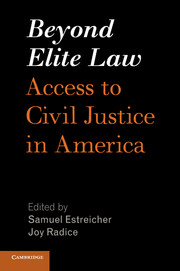Book contents
- Frontmatter
- Contents
- Beyond Elite Law
- Foreword
- List of Contributors
- Overview
- Overview
- PART I CURRENT STATE OF ACCESS TO LEGAL SERVICES
- PART II SOURCES OF LEGAL SERVICES ASSISTANCE FOR WORKING AMERICANS
- PART III FASHIONING A REFORM AGENDA
- PART IV CREATING A CULTURE OF SERVICE
- 43 Integrating Pro Bono with the Law Firm's Business
- 44 Facilitating Law Firm Pro Bono in Transactional Cases
- 45 What Bar Associations Can Do to Improve Access to Civil Justice
- 46 The Teaching Law Office: Service and Learning in the Law School Years
- 47 The Emergency-Room Law School Clinic
- 48 CUNY Law School's Community-Based and Community-Empowering Clinics
- 49 A New Law School in Texas to Address Unmet Legal Needs
- 50 Public Service Residency in Lieu of the Third Year of Law School
- Index
47 - The Emergency-Room Law School Clinic
from PART IV - CREATING A CULTURE OF SERVICE
Published online by Cambridge University Press: 05 May 2016
- Frontmatter
- Contents
- Beyond Elite Law
- Foreword
- List of Contributors
- Overview
- Overview
- PART I CURRENT STATE OF ACCESS TO LEGAL SERVICES
- PART II SOURCES OF LEGAL SERVICES ASSISTANCE FOR WORKING AMERICANS
- PART III FASHIONING A REFORM AGENDA
- PART IV CREATING A CULTURE OF SERVICE
- 43 Integrating Pro Bono with the Law Firm's Business
- 44 Facilitating Law Firm Pro Bono in Transactional Cases
- 45 What Bar Associations Can Do to Improve Access to Civil Justice
- 46 The Teaching Law Office: Service and Learning in the Law School Years
- 47 The Emergency-Room Law School Clinic
- 48 CUNY Law School's Community-Based and Community-Empowering Clinics
- 49 A New Law School in Texas to Address Unmet Legal Needs
- 50 Public Service Residency in Lieu of the Third Year of Law School
- Index
Summary
What would a legal clinic look like that responded immediately and directly to the most pressing legal needs of working Americans? Modeled after an emergency-room medical rotation, Radice & Hertz envision an emergency-room clinic where law students are assigned to conduct intake, triage, and diagnose potential clients’ legal problems, and ultimately counsel or represent them in matters ranging from creating wills to fighting housing evictions.
Assessments of the nature and efficacy of legal education often compare the field unfavorably to medical education. It is typically said that our society wouldn't allow a new physician to treat patients without having gone through adequate clinical fieldwork instruction in addition to classroom learning, and yet we allow new lawyers to represent clients in profoundly consequential matters without having previously engaged in actual practice under expert supervision. With the very recent changes in the accreditation standards for law schools that come into effect next year, all law students will now have to take six credits of “skills instruction,” but even this new rule will not require student practice during law school since it can be entirely satisfied with simulation courses.
Looking to medical education for guidance, we will explore whether the emergency room of a teaching hospital can serve as a model for a “full immersion” law school clinic that would teach law students the complete array of cognitive and practical skills that are essential for effective lawyering. This chapter proposes an emergency-room clinic that would parallel emergency-room rotations for third-year medical students. As in medical school, law students would take classroom courses to ground them in substantive knowledge and professional values before they enter the emergency room. Once in the emergency-room clinic, law students would conduct intake, employ diagnostic skills, and pursue remedies under expert supervision and training, just as medical students do. In addition to serving educational goals, this clinic is a model for how law schools can respond directly to the civil access to justice crisis documented elsewhere in this book by representing low- and moderate-income individuals.
A CLIENT-DRIVEN MODEL
In the clinic, as in a hospital emergency room, students would conduct intake, triage client issues, and offer consultation and representation. The chapters in this book paint a clear picture of the far-ranging unmet civil legal needs that an emergency-room clinic can address.
- Type
- Chapter
- Information
- Beyond Elite LawAccess to Civil Justice in America, pp. 667 - 679Publisher: Cambridge University PressPrint publication year: 2016



